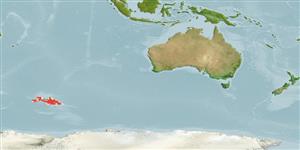Environment: milieu / climate zone / depth range / distribution range
Ecologia
marinhas batidemersal; intervalo de profundidade 380 - 1010 m (Ref. 30823), usually 600 - 700 m (Ref. 11892). Deep-water; 48°S - 52°S
Southern Ocean: Kerguelen, Skif Seamount (SW of Kerguelen) and off Heard Island.
Tamanho / Peso / Idade
Maturity: Lm ? range ? - ? cm
Max length : 12.6 cm TL macho/indeterminado; (Ref. 44814)
Descrição breve
Morfologia | Morfometria
Raios dorsais moles (total): 53-58; Raios anais moles: 48 - 53; Vértebras: 59 - 64. This species is characterized by the following: broad head; ventral and transverse mouth; smaller chin pores than mandibular pores and markedly approximated; opercular opening do not extend below 2nd and 3rd pectoral-fin rays; operculum about 1/3 HL; very large opercular lobe, extending far past of pectoral; rays of pectoral fin evenly decreasing in length without forming marked notch. Colour of peritoneum black, stomach dark brown to black (Ref. 44814).
A 1.45 cm SL fry was caught in the mesopelagic zone (Ref. 44814).
Life cycle and mating behavior
Maturidade | Reprodução | Desova | Ovos | Fecundidade | Larvas
Stein, D.L. and A.P. Andriashev, 1990. Liparididae. p. 231-255. In O. Gon and P.C. Heemstra (eds.) Fishes of the Southern Ocean. J.L.B. Smith Institute of Ichthyology, Grahamstown, South Africa. (Ref. 5196)
Categoria na Lista Vermelha da IUCN (Ref. 130435)
Ameaça para o homem
Harmless
Utilização humana
Mais informação
Nomes comunsSinónimosMetabolismoPredadoresEcotoxicologiaReproduçãoMaturidadeDesovaAgregação para desovaFecundidadeOvosDesenvolvimento dos ovos
Idade/TamanhoCrescimentoComprimento-pesoComprimento-comprimentoFrequência de comprimentoMorfometriaMorfologiaLarvasDinâmica larvarRecrutamentoAbundânciaBRUVS
ReferênciasAquaculturaPerfil para aquaculturaEstirpesGenéticaElectrophoresesHereditariedadeDoençasProcessamentoNutrientsMass conversion
ColaboradoresFotografiasStamps, Coins Misc.SonsCiguateraVelocidadeTipo de nataçãoÁrea branquialOutras referênciasCérebrosVisão
Ferramentas
Relatórios especiais
Descarregue XML
Fontes da internet
Estimates based on models
Preferred temperature (Ref.
123201): 1.7 - 2.9, mean 2.3 °C (based on 12 cells).
Phylogenetic diversity index (Ref.
82804): PD
50 = 0.5000 [Uniqueness, from 0.5 = low to 2.0 = high].
Bayesian length-weight: a=0.00525 (0.00237 - 0.01161), b=3.15 (2.96 - 3.34), in cm total length, based on LWR estimates for this (Sub)family-body shape (Ref.
93245).
Nível Trófico (Ref.
69278): 3.4 ±0.5 se; based on size and trophs of closest relatives
Resiliência (Ref.
120179): Médio, tempo mínimo de duplicação da população 1,4 - 4,4 anos (Assuming tmax>3).
Fishing Vulnerability (Ref.
59153): Low vulnerability (10 of 100).
